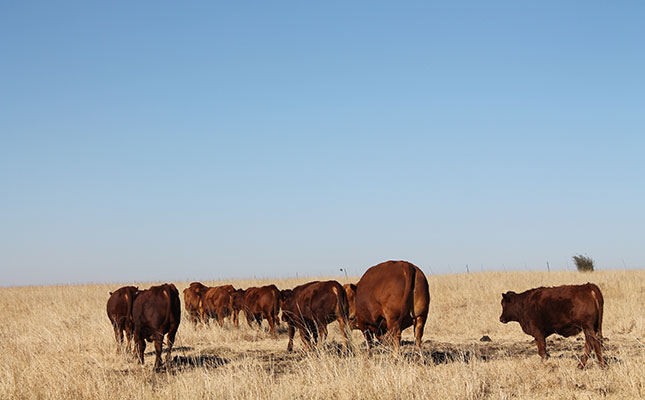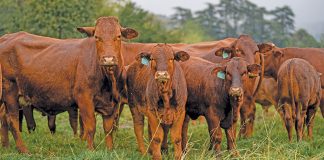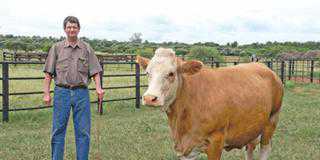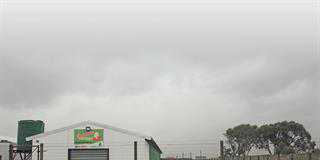
Photo: Annelie Coleman
Dirco Swart and his wife, Robyn, keep their Blinkmeneer Beefmaster stud on 580ha near Frankfort in the Eastern Free State. The stud, started in 2010, consists of 180 breeding females, of which a third are replacement heifers.
Swart uses eight bulls (four from his own stud) on his cows. A Blinkmeneer stud bull, DR 16 7302, went for R120 000 at the Sarwipi Beefmasters Auction held in August 2019. In July 2019, another Blinkmeneer bull, DR 16 1507, realised R48 000, the highest price at the Makiti Auction in Frankfort.
Annually, the stud produces 20 quality registered bulls, most of which are sold to commercial farmers. The focus is on producing top-performing animals, not on selling as many as possible.
Swart has followed in the footsteps of his father, Manie, a former principal of the Wilgerivier High School, who farmed part- time until his retirement. Swart, who works in the banking sector, says his father instilled in him a love of beef cattle
. The stud is named Blinkmeneer in memory of Swart’s late brother, Pieter, whose nickname for him was ‘Blink meneer’.
“It’s a pleasure to combine my love of numbers and the skills I acquired in the corporate environment with livestock breeding,” he says. “Numbers are important because, as a part-time breeder, I can’t afford to maintain animals that don’t excel economically.”
To maximise profit, Swart opted for a stud from day one, starting with 38 cows and two bulls on 210ha of leased land. He maintains that producing stud animals costs very little more than raising commercial ones, but the return on investment for a stud animal is considerably higher.
Choosing the breed
Being a part-time farmer is challenging, Swart admits, and his choice of cattle breed was therefore crucial.
Because of the limited amount of time he can spend on the farm, he cannot afford a breed that requires mollycoddling. He stresses, moreover, that to be effective in a commercial herd, stud cattle have to be treated as commercial animals.
Merely having the right ‘papers’ does not make a truly effective stud animal; the proof of the pudding lies in its performance.
With all this in mind, he sought a no-nonsense breed with sound fundamentals that made economic sense, and finally decided on the Beefmaster.
A synthetic breed, the Beefmaster is about 50% Brahman, 25% Hereford and 25% Shorthorn. The breed was developed primarily to produce quality meat at the lowest cost, which equates to more profit.
Swart advises prospective part-time breeders to gain as much knowledge as possible from experienced breeders before embarking on a beef cattle production concern. This goes for all aspects of production, including the most appropriate cattle breed, breeding practices, new technology, and veld management.
“After all, a lack of grass means a lack of meat. Sound management is critical for part-time breeders, especially when it comes to stud farming. I also learnt it was vital to start with the best animals I could afford to guarantee a sound genetic base.”
No pampering
He says the Beefmaster’s fertility, hardiness, weight, milk production, adaptability and temperament make it the ideal breed for extensive farming conditions. Blinkmeneer animals have to perform well on the veld.
The commercial beef producer is Swart’s main client, and he sees it as his responsibility as a stud breeder to enable his clients to produce the maximum kilograms of beef per hectare.
This is why animal recording forms such a vital part of the stud. His philosophy is not simply to breed a cow that produces a calf every year, but to breed one that produces a top-performing calf every year.
Animal recording and estimated breeding values (EBVs) are crucial to his enterprise, he explains.
The purpose of bull selection, for example, is to choose a bull that will maintain the good qualities of a cow herd and improve on its poor qualities.
It therefore makes financial sense to have a specific goal in mind when selecting a bull, and to ensure that such a bull meets the requirements as expressed in its EBVs. Such a list could include, for example, fertility, length, width, muscling, growth and milk production.
Swart serves as chairperson of the Eastern Free State branch of the Veldbull-Ram Organisation of Southern Africa (VBRSA). The Blinkmeneer bulls are evaluated by means of VBRSA tests for traits such as growth, temperament, muscling and scrotal size.
This takes place during a veld testing period that could last from 120 to 150 days. A specific value is attached to every trait and eventually expressed as economic indices by VBRSA.
Selection criteria
A sensible balance between EBVs and conformation forms part of the Blinkmeneer breeding strategy. Swart plans selection criteria according to the genetic needs of the herd.
“It’s important to be clear on the requirements of a herd at any given time and to select genetics accordingly. For example, we take a new bull’s and its mother’s EBVs for milk into consideration should a need arise to increase milk production in a herd.”
Swart started using his own bulls in the herd in 2018.
He maintains a three-month breeding season, from November to the end of January. This means that calving starts in August to coincide with the arrival of summer and the recovery of the veld after winter.
The average annual rainfall on the farm is 620mm, but during the 2014/2015 season this dropped to as low as 420mm.
The sourveld grazing consists mainly of perennial tussock-forming red grass (Themeda triandra) and 62ha of weeping love grass (Eragrostis curvula) planted pastures.
Swart says that weeping love grass is particularly well suited to the climatic conditions of the Eastern Free State. It not only grows faster than natural grazing, but turns green earlier in the season.
The planted pastures are baled for winter. The farm is divided into 17 camps with a stocking rate of 1 LSU/3ha.
Artificial insemination
About 40% of the herd is artificially inseminated (AI). Swart makes use of local as well as US genetics, and carefully matches the genetics to improve specific traits. The cows earmarked for AI are selected about two-and-a-half months before the insemination date to bring them up to condition, thus ensuring the highest possible conception rates.
“The next step in the AI process is to review the programme with my local vet, who does the AI for me. The AI programme is planned to allow the cows to give birth in early spring,” he says.
Hardiness and adaptability are critical, explains Swart. The lack of grain stover or crops in winter means that his animals have to survive and even thrive on the resources available.
This is why VBRSA testing on the veld is important: it is an essential tool to determine which animals produce the most meat from the veld.
A trait in the Beefmaster that makes it well suited to crossbreeding is that it adapts easily to nearly any environment yet still yields the production efficiency it is well known for, says Swart.
He adds that the future of the breed is bright, as its calf-to-cow weight ratio at weaning is amongst the highest of beef cattle breeds in South Africa.
“I’ve seen a significant improvement in the quality of Beefmaster cattle today from when I started in 2010. Breeders are placing more emphasis on efficiency and economic viability.”
Email Dirco Swart at [email protected].













